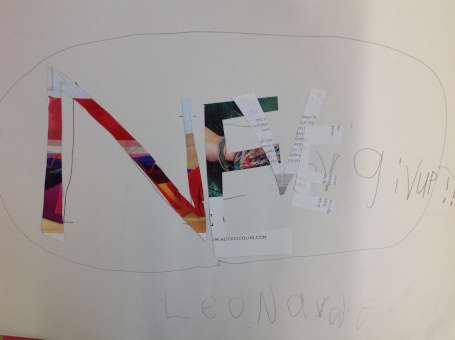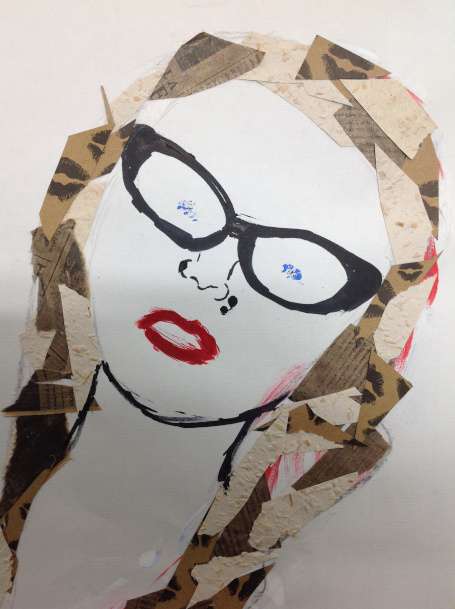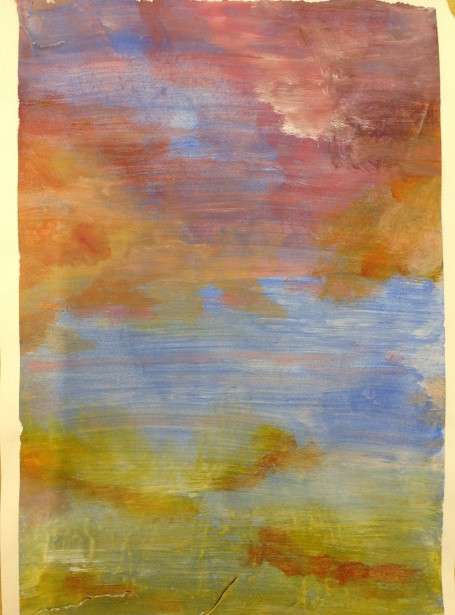

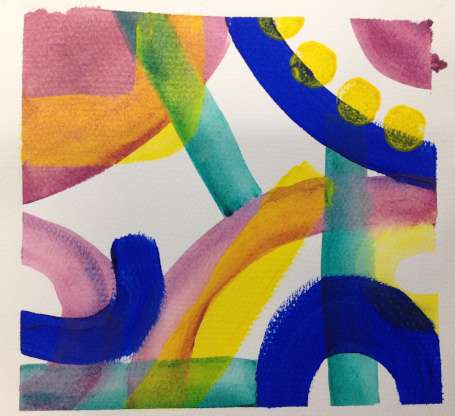
This week we tackled glazing and blending in acrylic. Instead of a still life, I suggested splitting up the paper into sections with masking tape in order for each box to be a different experiment. We used soft brushes in order to get a softer effect than is possible with the stiffer ones, and diluted the paint with water in order to build up translucent layers. It’s a great technique for making abstract patterns – I could imagine many of the results as…
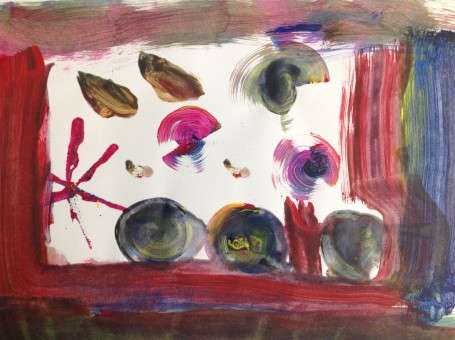
So again this week we were painting without brushes, this time with sponge brushes – actually pieces of foam stuck on a stick. We looked at the work of Howard Hodgkin for inspiration, as his broad brush strokes with multiple colours on them are exactly the effects that sponge brushes can do so easily. It’s particularly exciting when the colours mix on the sponge, and when you twist and twirl the brush. This is another technique in which giving yourself less control –…
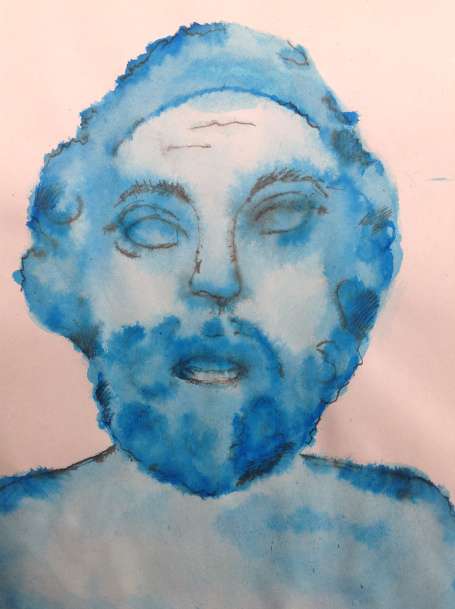
This term we are going back to basics and focusing on different painting or drawing tools. And this week it’s back to basics with our subject matter – classical sculptures. We have a few plaster casts in the studio, and I printed out some pictures of Greek and Roman statues to choose from. Taking inspiration from this Access Art session, I introduced the use of pen and ink – in which we find the shadows using a soft brush and coloured ink, using…

This week I asked the kids to make book covers. What book was up to them, and what age. I showed them some examples, and we talked about what makes a good cover, how you need to match the font to the style and content of the book, how book covers indicate for what age they are meant etc. And then of course, some weren’t satisfied with just a cover and made a whole book! Some of our older children wanted instead to…

This week I took inspiration from a painting by my grandmother, who was also an artist. She often worked with text, and in this painting she painted her letters in transparent layers so that the colours change when they overlap. The kids used coloured acetate to create a similar effect and, understandably for some, the technique suggested pictures or patterns rather than text.

Continuing our theme of text, this time we used text (in the form of newspapers) for its different tonal values. Different sized text torn up will create different tonal shades – dark to light – and with that you have you palette and can create anything.Some also couldn’t resist adding a bit of colour from the newspapers! I assembled a group of fairly simple fruit, veg and white porcelain cups. As a warm up activity, we did ink and charcoal drawings of the…

foThe last two weeks of term we managed to build and paint spectacular houses, as well as finish off the hats, the transfers and anything else left finsihed ready for the exhibition next week. The houses were made with cotton fabric stiffened with PVA, a technique learned from fabric artist Angie Hughe. This was done before the class and left to dry outside in the sun. The result was a fabric that behaved more like card, so it could hold its shape, particularly…

This week we got to try out some millinery – using vilene (stiffened fabric), metal hair bands and sinamay (the net stuff that milliners use). AS well as my box of random fabrics. We had a wide range of designs from the pre-existing such as (tiny) top hats, witches hat and beefeater hats to the completely new such as the drooping swan and the fire hat. The stapler was invaluable here as a quick and easy way to attach the fabric without waiting…

Over two weeks (along with hat making – see my next post) the kids have been working with iron-on transfer dyes, also called disperse dyes. Here you paint onto paper and when it is dry you can iron what you’ve painted onto fabric. This is a great technique to play with as you do not have to simply transfer what you paint, you can cut it up, and mask areas when you are transferring – very much like printing. The first step is…

This week we used wire and fabric to make amazing sculptures. The idea came from Access Art but we didn’t use plinths this time, and the kids didn’t stick to people. The basic technique is to make a simple wire sculpture – e.g. a stick figure – and to cover it in strips of fabric ( I used a sheet from a charity shop). We used thin wire to keep wrapped around the fabric to keep it in place. Then they cut up…
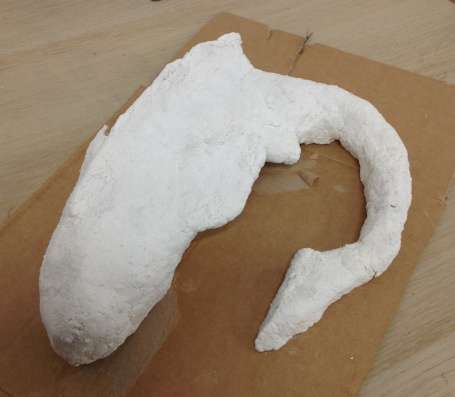
These two weeks we were busy with paper clay sculptures. Paper clay is a kind of paper mache, but the paper is mulched first before applying to the armature. I used this recipe from Jonni Good and it worked really well. The first step is to create the armature. What worked best was cardboard and scrunched up newspaper (careful to scrunch up the newspaper as tight as you can) but wire is also possible. Its really important that the sculpture is as tight…

This week the kids used all manner of pattern making techniques to create a wonderfully vibrant fashion catwalk – with cardboard human and other animal mannequins. The process was simple enough – but the results certainly weren’t. We had scarfs, saris, hats, capes, boots – you name it! Using techniques such as scarffito (sratching into wet paint to reveal a painted layer underneath) and stenciling they first made their ‘fabric’ by covering a piece of A4 paper with their pattern design. While these…

This half term we had another eclectic mix of activities on offer. The sculpture activities seemed particularly popular – including making abstract sculptures out of bike parts, more delicate sculptures out of wet toilet paper (surprisingly able to hold a shape) and of course many varied and imaginative cardboard creations! This time we also had a few bold children embarking on a 3-day project in which a small group designed and constructed a fish tank, complete with a futuristic city inside – called…

This week I showed the kids some basic, and some more complex, ways of weaving with paper. With help from Naomi Kendall, who provided this helpful post on the subject, we made some beautiful designs, using both strips of coloured paper and strips of magazines to make some v beautiful patterns. Of course, you don’t need to keep to the regular patterns I demonstrated. Some adventurous children deviated from the patterns with strips of different widths, as well as colours which did not…

Week 2 and this week we made paper mosaics. But we weren’t limiting ourselves to the simple, regular square types, oh no. We had strips, rectangles, dots, the lot! And used magazines as well as coloured card. A really simple technique, ideal for the younger ones, is to cover a piece of paper in strips and then on the reverse draw the outline of an animal (remember to choose an animal that is recognisable from its silhouettes – so generally this means side-on).…

Welcome to our new term! This term will be all about paper! Each week a different activity using paper (or card).. First up was tissue paper – surprisingly versatile. While of course you can make some lovely collages with tissue paper, especially using its translucency to create different colours where they overlap, and coating in diluted PVA to bring out those colours. But you can also use bleeding tissue paper to stain the paper you are working on – as one child said,…

Last week of term this week so yes, it’s time to paint the modroc sculptures! Everyone came with brilliant ideas of how to paint the sculptures they’ve been making the past two weeks. We used acrylic paint which is easy to paint details or corrections on top, once dry. Some even added other elements such as tissue paper wings or paper clothing. Love the results!

This week we tackled autumn leaves in watercolours. They really are the most beautiful subject, i think, and perfect for this tricky medium. There are techniques for all levels from patient layering, fluid experimentation to even printing with the leaves (and combining all these as well!). Really the only proper rule is to start with the light colours first. The beauty of watercolour is all about letting the white of the paper shine through, thereby utilising their amazing, and unique, transparency. Then you…

